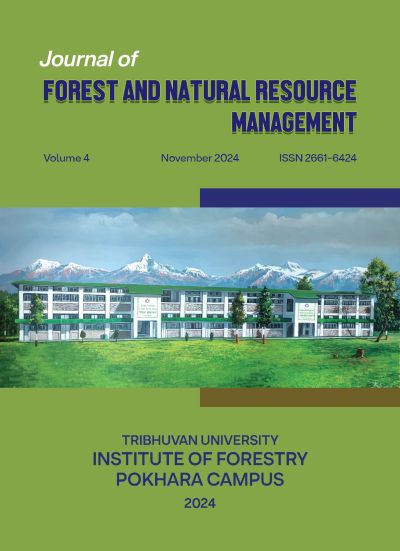Spatial Assessment of Forest Fire Risk Across Forest Types in Palpa District, Western Nepal: A Remote Sensing and GIS Approach
DOI:
https://doi.org/10.3126/jfnrm.v4i1.74231Keywords:
Fire behavior, fire hazard, fire management, fire vulnerabilityAbstract
Forest fire is one of the challenging issues of forest management in Nepal. Climate change has triggered forest fire occurrences in Nepal's hilly regions, increasing fire incidences and severity. This makes these regions more vulnerable to forest fires. The management of forest fires requires planning and effort from people to reduce its hazards effectively. This study aims to identify the forest fire risk zones across different forest types in Palpa district of western Nepal. We used different spatial variables related to land use and terrain to model the forest fire risk zones. Seven potential influential factors: land use land cover, slope, aspect, elevation, land surface temperature, distance to roads, and proximity to settlements were analyzed using a multi-parametric weighted index model to create a forest fire risk index and predict the overall forest fire risk map. The resulted fire risk map was classified into five risk zones: very low, low, medium, high, and very high, covering 3.11%, 12.55%, 12.88%, 45.07%, and 26.39% of the study area respectively. The prepared map was evaluated using field-level fire occurrence points and Visible Infrared Imaging Radiometer Suite (VIIRS) fire points. The fire occurrence points were overlaid on forest-type maps to assess fire occurrence across different forest types. The accuracy assessment result shows that the model effectively identified the forest fire risk zones as most of the fire locations fell within these predicted regions. By forest type, Pine Forest was found to be the most vulnerable to fire followed by Sal Forest. The findings of this study enhance the understanding of forest fire risk zones, which is helpful to community members, planners, policymakers, and government agencies in preparing effective forest fire management strategies for this vulnerable district of Nepal.
Downloads
Downloads
Published
How to Cite
Issue
Section
License
© Institute of Forestry, Pokhara Campus




